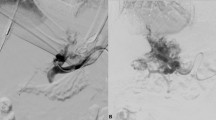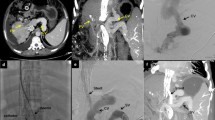Abstract
Purpose
This retrospective analysis was carried out to assess the feasibility and results of transjugular intrahepatic portal systemic shunt (TIPS) performed with ultrasound (US)-guided percutaneous puncture of the hepatic veins.
Material and methods
Over a period of 3 years, 153 patients were treated with TIPS at our centre. In eight cases, a percutaneous puncture of the middle (n=7) or right (n=1) hepatic vein was required because the hepatic vein ostium was not accessible. Indications for TIPS were bleeding (n=1), Budd-Chiari syndrome (n=1), ascites (n=2), reduced portal flow (n=1) and incomplete portal thrombosis (n=3). A 0.018-in. guidewire was anterogradely introduced into the hepatic vein to the inferior vena cava (IVC) through a 21-gauge needle. In the meantime, a 25-mm snare-loop catheter was introduced through the jugular access to retrieve the guidewire, achieving through-andthrough access. Then, a Rosch-Uchida set was used to place the TIPS with the traditional technique.
Results
Technical success was achieved in all patients. There was one case of stent thrombosis. One patient died of pulmonary oedema. Three patients were eligible for liver transplantation, whereas the others were excluded due to shunt thrombosis (n=1) and previous nonhepatic neoplasms (n=3).
Conclusions
The percutaneous approach to hepatic veins is rapid and safe and may be useful for avoiding traumatic liver injuries.
Riassunto
Obiettivo
Scopo del presente lavoro è stato analizzare retrospettivamente fattibilità e risultati della transjugular intrahepatic portal systemic shunt (TIPS) confezionata con puntura percutanea eco-guidata delle vene epatiche.
Materiali e metodi
Nell’arco di 3 anni, 153 pazienti sono stati sottoposti a TIPS. In 8 casi si è resa necessaria la puntura percutanea delle vene epatiche mediana (n=7) o destra (n=1), dopo tentativi fallimentari di cateterismo retrogrado ostiale. Le indicazioni alla TIPS erano: 1 sanguinamento, 1 sindrome di Budd-Chiari, 2 asciti, 1 ipoafflusso portale e 3 trombosi portali incomplete. Attraverso un ago di 21G per via anterograda è stata introdotta dalla vena epatica in vena cava inferiore (VCI) una guida di 0,018 pollici. Contemporaneamente dall’accesso giugulare la guida è stata catturata ed esteriorizzata con un catetere a laccio di 25 mm, per veicolare su di essa il set di Rösch-Uchida e confezionare la TIPS con tecnica classica.
Risultati
Il successo tecnico è stato ottenuto in tutti i pazienti. Abbiamo registrato 1 trombosi dello stent. Un paziente è deceduto per edema polmonare; 3 pazienti sono eleggibili per il trapianto epatico, mentre gli altri sono stati esclusi per occlusione dello shunt (n=1) o pregresse neoplasie extraepatiche (n=3).
Conclusioni
L’approccio percutaneo alle vene epatiche è rapido, sicuro ed utile nell’evitare lesioni epatiche traumatiche.
Similar content being viewed by others
References/Bibliografia
Haskal ZJ, Martin L, Cardella JF et al (2003) Quality improvement guidelines for transjugular intrahepatic portosystemic shunts. J Vasc Interv Radiol 14:S265–S270
Longo JM, Bilbao JI, Roussaeau HP et al (1992) Color Doppler-US guidance in transjugular placement of intrahepatic portosystemic shunts. Radiology 184:281–284
Grosso M, Spalluto F, Anselmetti GC et al (1992) Percutaneous transjugular intrahepatic portosystemic shunt (TIPS). The preliminary experience and proposal of a new method. Radiol Med 84:619–625
Raza SA, Walser E, Hernandez A et al (2006) Transhepatic puncture of portal and hepatic veins for TIPS using a single-needle pass under sonographic guidance. AJR Am J Roentgenol 187:W87–W91
Gasparini D, Del Forno M, Sponza M et al (2002) Transjugular intrahepatic portosystemic shunt by direct transcaval approach in patients with acute and hyperacute Budd-Chiari syndrome. Eur J Gastroenterol Hepatol 14:567–571
Boyvat F, Harman A, Ozyer U et al (2008) Percutaneous sonographic guidance for TIPS in Budd-Chiari syndrome: direct simultaneous puncture of portal vein and inferior vena cava. AJR Am J Roentgenol 191:560–564
Gazzera C, Righi D, Valle F et al (2009) Fifteen years’ experience with transjugular intrahepatic portosystemic shunt (TIPS) using bare stents: retrospective review of clinical and technical aspects. Radiol Med 114:83–94
Tublin ME, Towbin AJ, Federle MP et al (2008) Altered liver morphology after portal vein thrombosis: not always cirrhosis. Dig Dis Sci 53:2784–2788
Yoshiura K, Sawabe M, Esaki Y et al (1998) Extreme right lobar atrophy of the liver: a rare complication of autoimmune hepatitis. J Clin Gastroenterol 26:334–336
Ozaki K, Matsui O, Kobayashi S et al (2010) Selective atrophy of the middle hepatic venous drainage area in hepatitis C-related cirrhotic liver: morphometric study by using multidetector CT. Radiology 257:705–714
Rhu J, Malagò M, Busch Y et al (2005) Management of Budd-Chiari syndrome. Dig Dis Sci 50:540–546
Sharma S, Texeira A, Texeira P et al (2004) Pharmacological thrombolysis in Budd Chiari syndrome: a single centre experience and review of the literature. J Hepatol 40:172–180
Li T, Zhai S, Pang Z et al (2009) Feasibility and midterm outcomes of percutaneous transhepatic balloon angioplasty for symptomatic Budd-Chiari syndrome secondary to hepatic venous obstruction. J Vasc Surg 50:1079–1084
Corso R, Intotero M, Solcia M et al (2008) Treatment of Budd-Chiari syndrome with transjugular intrahepatic portosystemic shunt (TIPS). Radiol Med 113:727–738
Quateen A, Pech M, Berg T et al (2006) Percutaneous transjugular direct portocaval shunt in patients with Budd-Chiari syndrome. Cardiovasc Intervent Radiol 29:565–570
Yang JY, Feng GS, Liang HM et al (1997) Reestablishment of second hepatic hilum: a new technique for treatment of Budd-Chiari syndrome. Radiol Pract 12:47–51
Petersen B, Uchida BT, Timmermans H et al (2001) Intravascular US-guided direct intrahepatic portocaval shunt with a PTFE-covered stent-graft: feasibility study in swine and initial clinical results. J Vasc Interv Radiol 12:475–486
Peynircioglu B, Shorbagi AI, Balli O et al (2010) Is there an alternative to TIPS? Ultrasound-guided direct intrahepatic portosystemic shunt placement in Budd-Chiari syndrome. Saudi J Gastroenterol 16:315–318
Maleux G, Pirenne J, Vaninbroukx J et al (2004) Are TIPS stent-grafts a contraindication for future liver transplantation? Cardiovasc Intervent Radiol 27:140–142
Author information
Authors and Affiliations
Corresponding author
Rights and permissions
About this article
Cite this article
Gazzera, C., Fonio, P., Gallesio, C. et al. Ultrasound-guided transhepatic puncture of the hepatic veins for TIPS placement. Radiol med 118, 379–385 (2013). https://doi.org/10.1007/s11547-012-0853-3
Received:
Accepted:
Published:
Issue Date:
DOI: https://doi.org/10.1007/s11547-012-0853-3
Keywords
- Interventional radiology
- Transjugular intrahepatic portosystemic shunt
- Interventional ultrasonography
- Hepatic veins




